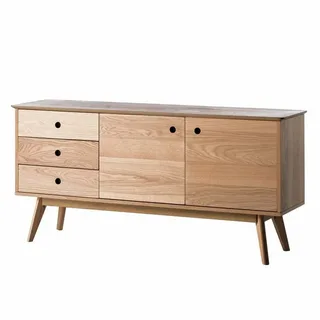The sideboard is a staple of home décor, especially in dining and living rooms, known for its blend of function and style. But where did this piece of furniture come from, and how has it transformed over time? In this article, we’ll explore the history and evolution of the sideboard, tracing its roots from medieval times to its current place in modern homes.
Origins in Function: The Early Sideboard
The earliest sideboards can be traced back to medieval Europe, where they were used as simple boards or tables placed against walls for serving food. These primitive versions lacked storage and were more functional than decorative. As households became wealthier and more interested in formal dining, the sideboard began to evolve.
By the 18th century, the sideboard had become a more permanent fixture in upper-class homes. Cabinetmakers in England and France started designing sideboards with built-in drawers and cabinets to store silverware, dishes, and linens. These were often crafted from rich woods like mahogany and embellished with ornate carvings, reflecting the wealth and taste of their owners.
Victorian Influence and Industrial Expansion
During the Victorian era, the sideboard became grander and more elaborate. It was now a symbol of status and elegance, often placed prominently in the dining room. The designs featured heavy carving, mirrored backs, and intricate inlays.
With the advent of the Industrial Revolution, mass production made furniture like the sideboard more accessible to the growing middle class. This shift marked a key point in the history and evolution of the sideboard, as it moved from an elite luxury to a common household item.
Mid-Century Modern and Minimalist Trends
In the mid-20th century, furniture design took a sharp turn toward simplicity and functionality. Mid-century modern designers such as Charles and Ray Eames and Arne Vodder reinvented the sideboard with clean lines, tapered legs, and minimalist silhouettes.
These modern sideboards were no longer confined to the dining room. Homeowners began using them in entryways, living rooms, and even bedrooms for stylish storage. This flexibility marked another important stage in the history and evolution of the sideboard, showing how adaptable the piece had become to changing lifestyles.
Today’s Sideboard: Style Meets Versatility
Today, sideboards come in a wide range of styles, materials, and sizes to suit every type of interior. Whether made from reclaimed wood for a rustic feel or sleek metal for a contemporary look, the modern sideboard balances practicality with visual appeal.
As design trends continue to shift, the sideboard remains relevant, reflecting both its historical roots and its ongoing evolution. From buffet server to media console, this piece of furniture continues to adapt to the needs of modern living.
Conclusion
The history and evolution of the sideboard tells a broader story about how our homes and lifestyles have changed over the centuries. From a simple serving board to a stylish storage solution, the sideboard has proven its staying power. As both a functional and decorative piece, it remains an essential part of home design today.


